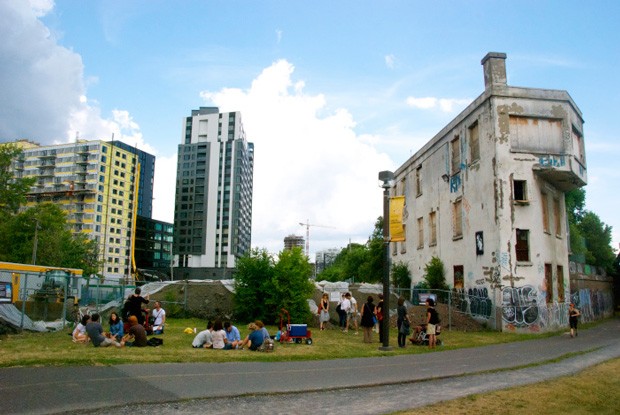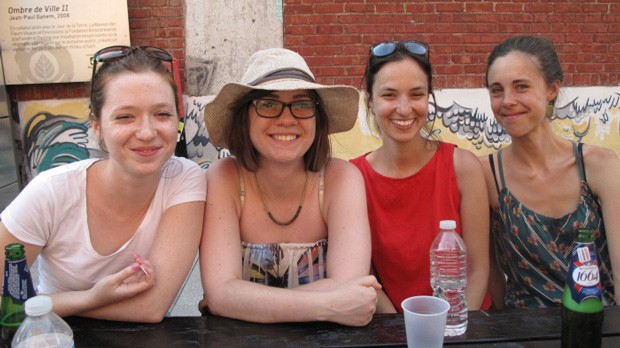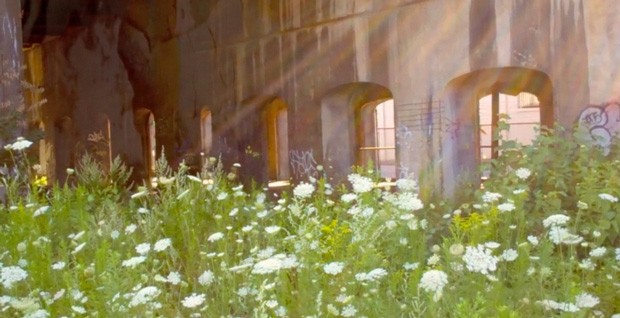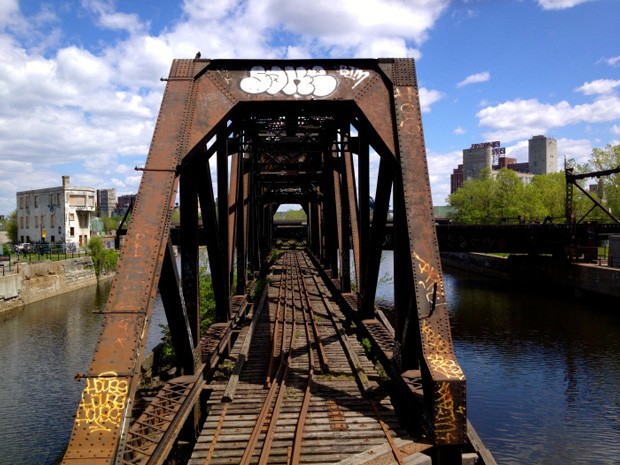Transforming Montreal’s post-industrial landscape
 Points de view urban lab next to the Wellington Tower. | Photo by Camille Bédard
Points de view urban lab next to the Wellington Tower. | Photo by Camille Bédard
The Wellington Tower stands at the crossroads between four Montreal neighbourhoods: Old Montreal, Ville-Marie, Little Burgundy and Pointe-Saint-Charles. Once one of Montreal’s iconic post-industrial buildings, it now stands in ruin, abandoned for over a decade.
But that’s about to change. In the next year, the tower will be repurposed by the city as a venue for community and cultural activities, and Concordia is helping lead the charge.
A group of faculty members, students and alumni have teamed up with community organizations to develop Points de vue, a series of public consultation events they call in-situ urban laboratories. The four labs serve to identify the cultural and social themes that need to be emphasized in order for the site’s transformation to be meaningful to the communities it’s intended to serve.
 Points de vue “Les Jeunes” curatorial team, from left: Noémi Despland-Lichert, Alyse Tunnell, Chantale Potié and Camille Bédard. | Photo by Thomas Strickland.
Points de vue “Les Jeunes” curatorial team, from left: Noémi Despland-Lichert, Alyse Tunnell, Chantale Potié and Camille Bédard. | Photo by Thomas Strickland.
The project is designed to serve as a witness to the site, as well as an archiving mechanism for mapping public exchanges and reflections. The organizers hope to create a space for debate about the tower’s future, its historical significance and the meaning of repurposing it into a place for public, cultural and community activities.
“The aim of our ‘urban labs’ is to share, gather and document the community’s perspective on the building’s industrial past and its post-industrial future as a cultural centre,” says Cynthia Hammond, chair of the Department of Art History and a member of the Points de vue team.
 Smith Street Viaduct, Griffintown, Montreal, 2011. | Photo by Shauna Janssen
Smith Street Viaduct, Griffintown, Montreal, 2011. | Photo by Shauna Janssen
The first lab took place on June 28. It consisted of a treasure hunt in which children and their parents mapped and drew their way through the area surrounding the tower. The activity was geared to help kids learn about the city by navigating the neighbourhood’s history, its architecture and its landscape.
The second lab focused on themes of accessibility, spatial justice and inclusive design practices. The participants walked from the Darling Foundry to the Wellington Tower, identifying their encounters with inaccessibility or spatial injustices along the way.
A third lab takes place on Saturday, August 23. Called The Postindustrial landscape Lost + Found: Archiving Urban Change, it will guide participants in discovering, collecting and archiving the transition that is taking place in the streets, parks, shops and residences surrounding the Wellington Tower.
“Our post-industrial landscape workshop is an archeological exploration of the processes of rapid urban change,” says Points de vue co-director Thomas Strickland.
 The tower overlooks a defunct train bridge in Griffintown, a remnant of the buildings original purpose when owned by the Canadian National Railway Company. | Photo by Shauna Janssen
The tower overlooks a defunct train bridge in Griffintown, a remnant of the buildings original purpose when owned by the Canadian National Railway Company. | Photo by Shauna Janssen
The fourth and final urban laboratory on Urban Greening will focus on re-imagining the landscape — how green space is rapidly disappearing to make room for new residential and private real-estate developments. Participants are invited to learn about the lesser known ecological diversity of the area, with a focus on its post-industrial urban spaces. Facilitators will collect the creative urban-ecology strategies proposed by participants.
The Points de vue team will share their findings from the labs in a public exhibition at the Darling Foundry, and Concordia’s Centre for Oral History and Digital Storytelling will host the permanent archive, where findings will be made available for researchers and members of the public.
Points de vue is working in partnership with Concordia's Department of Art History and the Centre for Oral History and Digital Storytelling. The initiative is funded by Concordia’s Aid to Research Related Events (ARRE) program and the Darling Foundry.
A vernissage for the exhibition will take place at the Darling Foundry (745 Ottawa St.) on Saturday, September 27, 2014, from 12 to 7 p.m.